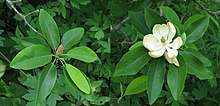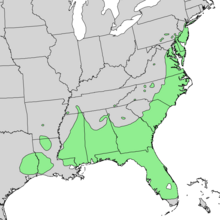Magnolia virginiana
| Sweetbay magnolia | |
|---|---|
 |
|
| Scientific classification | |
| Kingdom: | Plantae |
| (unranked): | Angiosperms |
| Phylum: | Tracheophyte |
| (unranked): | Magnoliids |
| Order: | Magnoliales |
| Family: | Magnoliaceae |
| Genus: | Magnolia |
| Subgenus: | M. subg. Magnolia |
| Section: | M. sect. Magnolia |
| Species: | M. virginiana |
| Binomial name | |
|
Magnolia virginiana L. |
|
 |
|
Magnolia virginiana, most commonly known as sweetbay magnolia, or merely sweetbay (also laurel magnolia, swampbay, swamp magnolia, whitebay, or beaver tree), is a member of the magnolia family, Magnoliaceae. It was the first magnolia to be scientifically described under modern rules of botanical nomenclature, and is the type species of the genus Magnolia; as Magnolia is also the type genus of all flowering plants (magnoliophytes), this species in a sense typifies all flowering plants.
Magnolia virginiana is an evergreen or deciduous tree to 30 m (100 ft) tall, native to the lowlands and swamps of the Atlantic coastal plain of the eastern United States. The original native range is thought to be from the eastern Gulf Coast to the lowlands of New Jersey. Whether it is deciduous or evergreen depends on climate; it is evergreen in areas with milder winters in the south of its range (zone 7 southward), and is semi-evergreen or deciduous further north. The leaves are alternate, simple (not lobed or pinnate), with entire margins, 6-12 cm long, and 3-5 cm wide. The bark is smooth and gray, with the inner bark mildly scented, the scent reminiscent of the bay laurel spice.
The flowers are creamy white, 8-14 cm diameter, with 6-15 petal-like tepals. The flowers carry a very strong vanilla scent that can sometimes be noticed several hundred yards away. The fruit is a fused aggregate of follicles, 3-5 cm long, pinkish-red when mature, with the follicles splitting open to release the 1 cm long seeds. The seeds are black but covered by a thinly fleshy red coat, which is attractive to some fruit-eating birds; these swallow the seeds, digest the red coating, and disperse the seeds in their droppings.
Magnolia virginiana is often grown as an ornamental tree in gardens, and used in horticultural applications to give an architectural feel to landscape designs. It is an attractive tree for parks and large gardens, grown for its large, conspicuous, scented flowers, for its clean, attractive foliage, and for its fast growth. In warmer areas Magnolia virginiana is valued for its evergreen foliage.
...
Wikipedia
